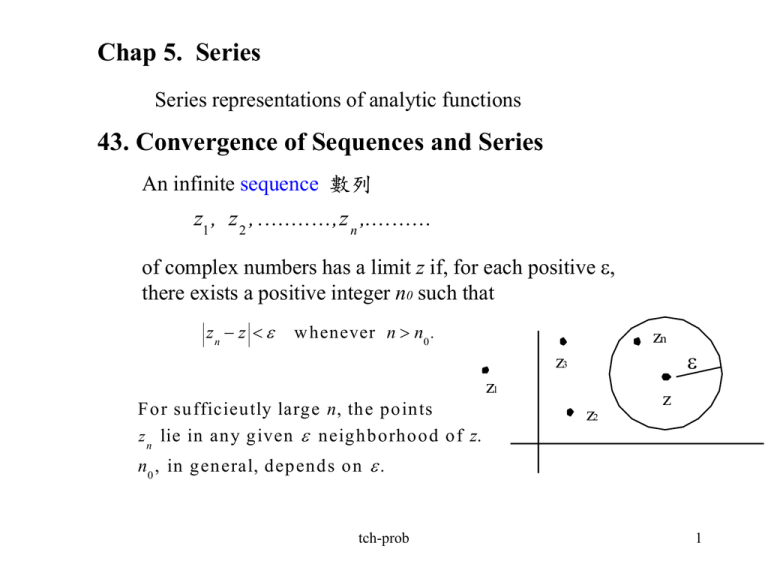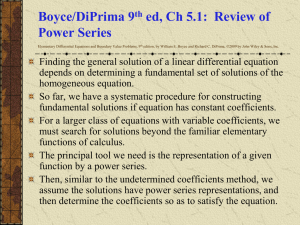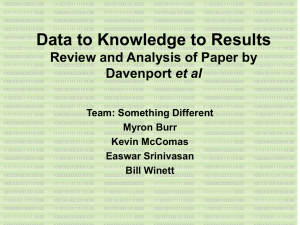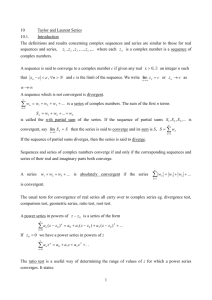Document
advertisement

Chap 5. Series Series representations of analytic functions 43. Convergence of Sequences and Series An infinite sequence 數列 z1 , z 2 , ...........,z n ,.......... of complex numbers has a limit z if, for each positive , there exists a positive integer n0 such that zn z w henever n n0 . zn z3 z1 For sufficieutly large n , the points z n lie in any given neighborhood of z. z2 z n0 , in general, depends on . tch-prob 1 The limit z is unique if it exists. (Exercise 6). When the limit exists, the sequence is said to converge to z. lim z z n n Otherwise, it diverges. Thm 1. S uppose z n x n iy n , lim n zn z iff z x iy then lim x n x, and n tch-prob lim y n y . n 2 An infinite series z n z1 z 2 ......... z n ............... (6) n 1 of com plex num bers converges to the sum S if the sequence N S N z n z1 z 2 .......... z N ( N 1, 2 , ......) n 1 of partial sum s con verges to S . W e then w rite zn S n 1 T hm 2. S uppose z n x n iy n T hen z n S iff n 1 tch-prob , S x iy n 1 n 1 x n x and y n y 3 A necessary condition for the convergence of series lim z n 0 is that (6) n The terms of a convergent series of complex numbers are, therefore, bounded, i.e., z M. n Absolute convergence: n 1 n 1 zn S ince xn xn yn 2 2 xn 2 y n 2 , converges yn xn 2 y n 2 x n and y n also converges n 1 n 1 xn , and y n converge n 1 n 1 From T hm . 2 , z n converge n 1 Absolute convergence of a series of complex numbers implies convergence of that series. tch-prob 4 44. Taylor Series Thm. Suppose that a function f is analytic throughout an open disk z z 0 R0 . Then at each point z in that disk, f(z) has the series representation f ( z ) an ( z - z0 )n n0 w h ere f (n ) ( z0 ) an n 0 , 1, 2 , ..... n! z R0 z0 That is, the power series here converges to f(z) w hen z - z 0 R0 . tch-prob 5 This is the expansion of f(z) into a Taylor series about the point z0 Any function that is known to be analytic at a point z0 must have a Taylor series about that point. (For, if f is analytic at z0, it is analytic in some neighborhood z z 0 ε of z 0 (sec . 20 , p 55) . may serve as R0 is the statement of Taylor’s Theorem) pf . (a) w hen z 0 0 f ( n ) ( 0) n prove f ( z ) z n ! n0 Let C 0 : C ircle z r0 Positively oriented within ( z R0 ) ~ Maclaurin series. z0=0的case z R0 s z r and z is interior to it. r0 R0 0 C0 tch-prob 6 The Cauchy integral formula applies: f ( s ) ds f ( z ) 1 c 2 πi 0 s z 1 now 1 1 s z s 1- z ( z 1), s z 1 s s N 1 N n 1 z and z 1- z n 0 1 z ( z 1) (Exeicise 13, sec. 6). z )N ( s 1 1 ( ( z )n ) s z s n0 s z 1 s N 1 N 1 z n N z n 1 (s z)s N n0 s tch-prob 7 f ( s ) ds N 1 f ( s ) ds n f ( s ) ds N z z c s z c ( s z ) s N c n 1 0 0 0 s n0 N 1 2 i n0 f (n) (0) n! z n z N c f ( s ) ds N 0 (s z)s (n) N 1 f (0) n f ( s ) ds f ( z ) 1 c z ρN ( z ) s z 2 πi 0 n! n0 N f ( s ) ds w her e ρ N ( z ) z 2 πi c0 ( s z ) s N S uppose that z r then if s is a point on C 0 s z s z r0 r tch-prob 8 If f (s) M N M 2 π r0 M r0 r N ρN ( z) r ( ) N r r r0 2 π ( r0 r ) r0 0 B ut r 1, lim ρ N ( z ) 0 r0 主要 z N 1 s (n) f (0) n 原因 f (z) z n! n0 (b) For arbitrary z0 Suppose f is analytic when z z 0 R0 and note that the composite function f ( z z 0 ) must be analytic when ( z z 0 ) z 0 R0 tch-prob 9 Let g ( z ) f ( z z 0 ). The analyticity of g(z) in the disk z R0 ensures the existence of a Maclaurin series representation: g ( n ) ( 0) n g (z) z ( z R0 ) n! n0 f (n) ( z ) n 0 z or f ( z z 0 ) n! n0 R eplace z by z - z 0 , f (n) ( z ) 0 f (z) ( z z0 )n n 0 n! tch-prob 10 45 Examples Ex1. Since f ( z ) e z is entire It has a Maclaurin series representation which is valid for all z. f (n) (z) e z , f (n) (0) 1, zn z e ( z ) n 0 n! f ( z ) z 2 e 3 z is also entire. n z 2e 3 z 3 z n 2 n 0 n! n2 3 zn ( z ) ( n 2)! n2 tch-prob 11 Ex2. Find Maclaurin series representation of f ( z ) sin z f (2 n ) (0) 0 f (2 n 1) (0) ( 1) n , n 0 , 1, 2 , .... n z 2 n 1 sin z ( - 1) (2 n 1)! n0 ( z ) sinh z -i sin (iz ) Ex3. f ( z ) cos z f (2 n ) ( 0) ( 1) n n cos z ( - 1) n0 cosh z cos (iz ) f (2 n 1) z 2n (2 n )! tch-prob (0) 0 ( z ) 12 Ex4. 1 zn 1 z n0 sin ce f ( z 1) (n) (z) n! (1 z ) n 1 f ( n ) (0) n ! su b stitu te - z fo r z 1 ( 1) n z n 1 z n0 su b stitu te ( z 1) 1 - z fo r z 1 ( 1) n ( z 1) n ( z - 1 1) z n0 n n n (1 - z ) ( - 1) ( z - 1) n0 n0 tch-prob 13 Ex5. 2 2(1 z 2 ) 1 1 2 z 1 f (z) 3 5 z z z3 1 z 2 1 (2 - 1 ) z3 1 z 2 can not find a M aclaurin series fo r f ( z ) since it is not analytic at z 0 . B ut 1 1 z 2 z 4 z 6 ............( z 1 ) 1 z 2 H ence, w hen 0 z 1, f ( z ) 1 (2 - 1 z 2 z 4 z 6 ..............) z3 1 1 z z 3 z 5 ........... z3 z 為Laurent series 預告 tch-prob 14 46. Laurent Series If a function f fails to be analytic at a point z0, we can not apply Taylor’s theorem at that point. However, we can find a series representation for f(z) involving both positive and negative powers of (z-z0). Thm. Suppose that a function f is analytic in a domain R1 z z 0 R 2 , and let C denote any positively oriented simple closed contour around z0 and lying in that domain. Then at each z in the domain bn n f ( z ) an ( z - z0 ) n n0 n 1 ( z - z 0 ) tch-prob (1) 15 where f (z) dz a n 1 c 2π i ( z - z 0 ) n 1 ( n 0 , 1, 2 , ......) f (z) dz bn 1 c 2 π i ( z - z ) n 1 0 or ( n 1, 2 , .......) n C n ( z - z0 ) n - f (z) dz w h ere C n 1 c 2π i ( z - z ) n 1 f (z) ( R1 z z 0 R 2 ) (4) ( n 0 , 1, 2 , .....) (5) 0 (1) (4) are Laureut Series Pf: see textbook. Z f (s) f ( s ) ds f ( s ) ds c s z ds - c s z s z 0 2 1 2 πi f ( z ) tch-prob r R2 R1 Z0 C C2 C1 16 47. Examples The coefficients in a Laurent series are generally found by means other than by appealing directly to their integral representation. Ex1. n z ez ( z ) n0 n ! replace z by 1 z 1 z 1 1 1 1 1 ......... e n z 2! z 2 3! z 3 n 0 n! z no positive pow ers of z appear. (0 z ) 1 1 since b1 e z dz 1 c 2 πi c e 1 z dz 2 πi Alterative way to calculate tch-prob 17 Ex2. 1 is already in the form of a laurent series, w here z 0 i. ( z i)2 f ( z ) C n ( z i)n (0 z - i ) n w here C 2 1, all other coefficients are zero. f (z) S ince f ( z ) dz 1 C n 1 c 1 c dz 2π i n 1 2 i n 3 ( z - i) ( z i) 0 dz c ( z - i ) n 3 2 i w hen n -2 w hen n= -2 d1 dz z i [ c dz c 1 dz 2 π i n! ( z i)2 ( z - i)2 tch-prob 0] 18 Ex3. f (z) 1 1 1 ( z 1)( z 2) z 1 z 2 has two singular points z=1 and z=2, and is analytic in the domains D1 : z 1 D2 : 1 z 2 D3 : 2 z D3 D2 Recall that D1 1 1 zn 1 z n0 ( z 1) 2 0 (a) f(z) in D1 f (z) 1 1 -z 1 2 1 1- z 2 z 1 in D 1 2 z n (2 -n -1 1) z n f (z) zn n 1 2 n0 n0 n0 S in ce z 1 an d tch-prob ( z 1) 19 (b) f(z) in D2 1 1 f (z) 1 1 z 1 -( 1 ) 2 1 - z z 2 1 1 , z 1 , w h en 1 z 2 , z 2 1 1 1 n f (z) ( ) ( z )n z z 2 n0 2 n0 n 1 z (1 z 2) n 1 n 1 n0 z n0 2 1 1 n z (1 z 2) n n 1 z 2 n0 n 1 S in ce tch-prob 20 (c) f(z) in D3 1 f (z) 1 . 1 1 z 1- 2 z 1-1 z z 2 1 w hen 2 z since 1 1 , z z n 2 1 f (z) 1 n n 0 z n 1 n0 z n 1-2 (2 z ) n 0 z n 1 n 1 2 1 (2 z ) n z n 1 tch-prob 21 48. Absolute and uniform convergence of power series Thm1. n a n ( z - z 0 ) co n verg es n 0 w h en z z1 (z 1 z 0 ), th en it is ab so lu tely (1) If a p o w er series co n verg en t at each p o in t z in th e o p en d isk z - z 0 R1 , w h ere R1 z1 z 0 . z1 C o n verg es at z1 C o n verg es at all p o in ts in sid e th e circle z - z 0 R1. tch-prob z z0 R1 22 • The greatest circle centered at z0 such that series (1) converges at each point inside is called the circle of convergence of series (1). • The series CANNOT converge at any point z2 outside that circle, according to the theorem; otherwise circle of convergence is bigger. n a n (z-z 0 ) n 0 has circle of convergence z - z 0 R S uppose that Let S (z ) an (z - z0 ) n n0 N -1 S N (z ) an (z - z0 )n n 0 tch-prob (1) z z0 R 23 w rite N ( z ) S ( z ) S N ( z ) since (1) converges, N ( z ) 0 as ( z - z0 R ) N or for each , there is a N sw ch that N ( z ) w henever N N When the choice of N depends only on the value of and is independent of the point z taken in a specified region within the circle of convergence, the convergence is said to be uniform in that region. tch-prob 24 T hm 2. If z1 is in c. of. c. z - z0 R of a n ( z - z 0 ) n n 0 then that series is uniformly convergent in the closed disk z z 0 R1 , w here R1 z1 z 0 . R z z0 R1 z1 Corollary. A pow er series a n ( z - z 0 ) n represents a continuous function S ( z ) n0 at each point inside its circle of conv ergence z - z 0 R . tch-prob 25 49. Integration and Differentiation of power series Have just seen that a power series S ( z ) an ( z z0 )n n0 (1 ) represents continuous function at each point interior to its circle of convergence. We state in this section that the sum S(z) is actually analytic within the circle. Thm1. Let C denote any contour interior to the circle of convergence of the power series (1), and let g(z) be any function that is continuous on C. The series formed by multiplying each term of the power series by g(z) can be integrated term by term over C; that is, n g ( z ) S ( z ) dz a g ( z ) ( z z ) dz c n c 0 n0 tch-prob 26 Corollary. The sum S(z) of power series (1) is analytic at each point z interior to the circle of convergence of that series. Ex1. sin z z w ant to show f ( z ) 1 w hen z 0 w hen z 0 is entire 2 n 1 z n since sin z ( - 1) represent sin z for every z , (2 n 1)! n0 n z 2 n 1 ( 1) (2 n 1)! z 2 n 1 z 2 z 4 ............ n0 ( 1) n z 3! 5! (2 n 1)! n0 converges to f ( z ) w hen z 0 (4) But series (4) clearly converges to f(0) when z=0. Hence f(z) is an entire function. tch-prob 27 Thm2. The power series (1) can be differentiated term by term. That is, at each point z interior to the circle of convergence of that series, S' ( z ) n a n ( z - z 0 ) n 1 n0 Ex2. Diff. 1 z n0 ( - 1) n ( z 1) n ( z - 1 1) 1 ( - 1) n n ( z -1) n-1 z 2 n 1 1 ( - 1) n ( n 1)( z 1) n 2 z n0 tch-prob z -1 1 z -1 1 28 50. Uniqueness of series representation Thm 1. If a series n an ( z z0 ) n0 co n verg es to f ( z ) at all points interior to some circle z z 0 R , then it is the Taylor series expansion for f in powers of z z 0 . Thm 2. If a series n C n ( z - z0 )n converges to f(z) at all points in some annular domain about z0, then it is the Laurent series expansion for f in powers of z z 0 for that domain. tch-prob 29 51. Multiplication and Division of Power Series f ( z ) an ( z z0 )n n0 and g ( z ) bn ( z z 0 ) n n0 converges w ithin z z 0 R , Suppose then f(z) and g(z) are analytic functions in z z 0 R Their product has a Taylor series expansion f ( z ) g ( z ) cn ( z z 0 ) n n0 n cn a b k 0 k n-k tch-prob z z0 R C auchy product 30 Ex1. ez The Maclaurin series for 1 z is valid in disk z 1 ez 1 z (1 z 1 z 2 1 z 3 .....)(1 - z z 2 z 3 ........) 2 6 1 1 z 2 1 z 3 ..... z 1 2 3 Ex2. Zero of the entire function sinh z are the m um bers z nπi ( n 0 , 1, 2 , ... ) 1 1 So 1 z 2 sinh z z 3 ( 1 z 2 z 4 .......) 3! 5! has laurent series in the punctured disk 0 z π 1 1 1 . 1 7 z .....(0 z π ) z 2 sinh z z 3 6 z 360 z z (si nh z e e ) 2 tch-prob 31











